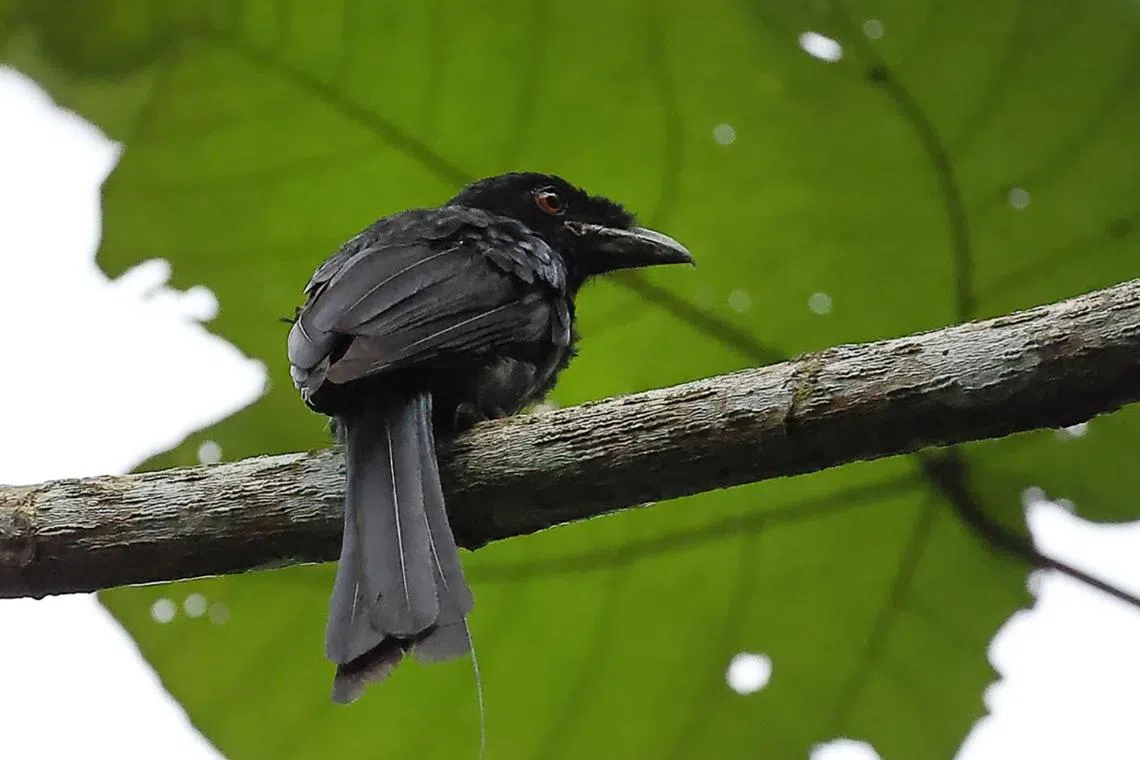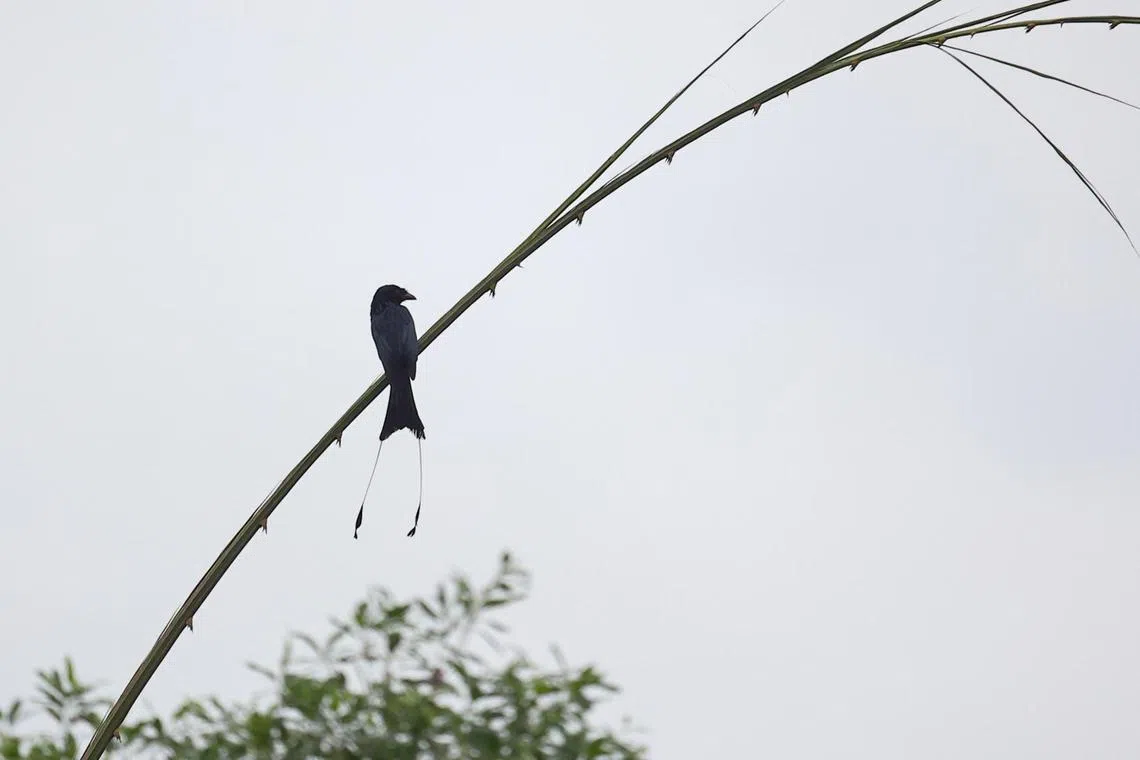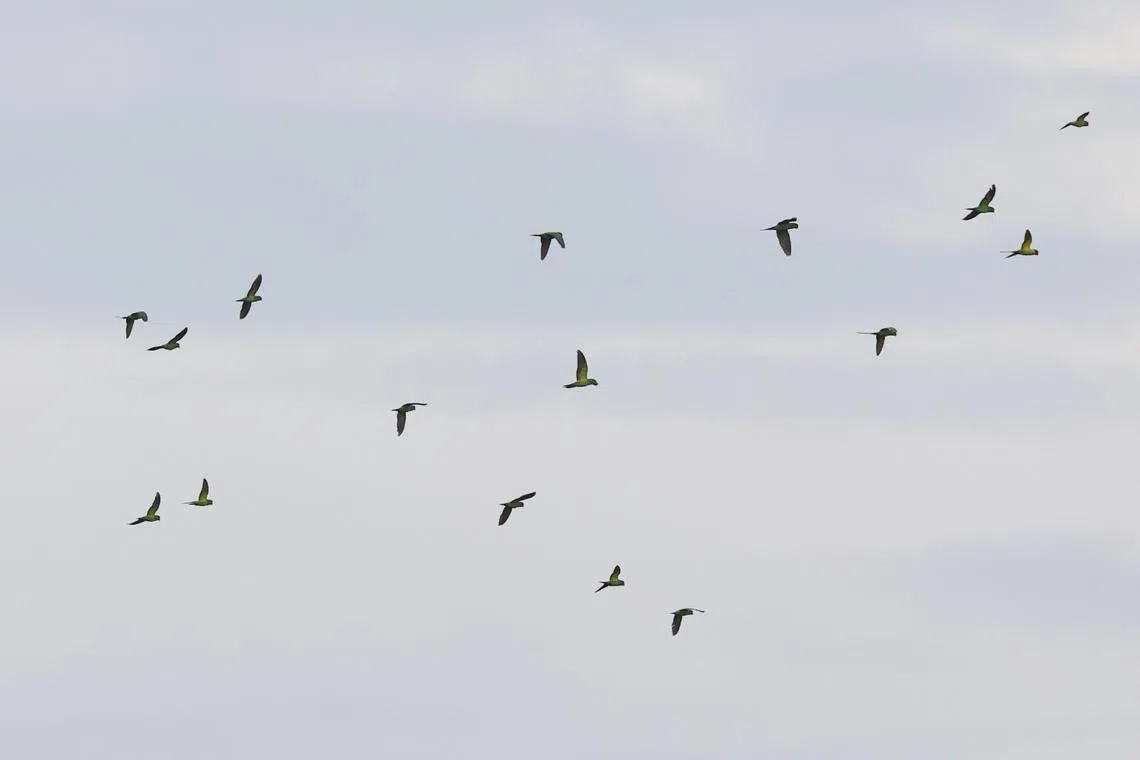‘Playing Pokemon with your ears’: Identifying birds by sound in Singapore’s nature reserve
Sign up now: Get ST's newsletters delivered to your inbox

A Greater Racket-tailed Drongo perching on a tree.
PHOTO: LIM KIM CHUAH
Follow topic:
SINGAPORE - During a networking dinner, an ardent birdwatcher leaned over to show me his list of bird sounds on an app that he described as a “birdsong Pokedex”.
Mr Lim Kim Chuah, 60, who is passionate about bird sounds, said each bird has a unique call that usually makes it immediately recognisable to the same species.
Such calls are necessary for birds to keep in touch with one another when they are separated and allows them to recognise one another amid other animal sounds in the forest.
“But for birdwatchers, it’s like playing Pokemon with your ears. You hear a bird, you tick it off your checklist and you move on,” he said.
“If you rely only on your eyes, trust me, you will be able to record only a fraction of the birds that you can record by sound.”
This was how I ended on a trip to the Central Catchment Nature Reserve with Mr Lim, a corporate manager, and two other bird sound enthusiasts – Dr Yeo Seng Beng, 63, and Dr Yong Ding Li, 38 – to identify birds by sound.
In the main Facebook groups populated by birdwatching enthusiasts in Singapore with memberships of 1,000 to around 30,000, the trio are among the few birders who identify birds by sound, said Mr Lim.
It is estimated that only around 10 birders in Singapore are specialists in bird sounds. Sound specialists are more efficient at birdlife surveys because of their ability to detect birds that normally can’t be seen, he said.
But they are hardly alone. A website, xeno-canto (“strange song” in Latin), shares wildlife sounds from around the world. The citizen science repository has one of the largest collections of bird sounds and its database has been frequently used in research papers.
To date, Mr Lim has recorded the calls of 250 species of birds, Dr Yeo 92 and Dr Yong a whopping 960, with two of the calls no one has recorded before. Their recordings have been used in research studies in Singapore.
As our group walked towards the seven-storey Jelutong tower, which overlooks the emergent layer of the canopy in the Central Catchment Natural Reserve, the three men would pause to identify each bird by their sounds and occasionally whistle the bird songs to jolt their memory and to call birds to them.
Mr Lim, who has been birding since he was 10, said his encounter with an experienced birder in Thailand in the early 90s started him on this endeavour.
“Unlike in Singapore, where bird sounds are easily identified in the forest because there is more silence than there are birds, hundreds of birds of different species (in Thailand) are singing all at once, overlapping each other’s sounds,” he said.
“I thought it would be impossible to isolate even a single sound, but I was with an experienced birder who was able to ‘fish’ out the songs of each bird, as he pointed in different directions.”
As the men busied themselves with recording the bird songs, Dr Yong, a regional coordinator for migratory bird conservation at BirdLife International, pointed to a lone bird perching atop a tree. It was as black as a raven, with two long wisps hanging from its tail like pendants.
As the bird let out several cries at regular intervals, like the high-pitched metallic cries of a sonar ray, Dr Yong identified it as a racket-tailed drongo, one of the famous imitators in Singapore’s jungle.
Drongo sound
He said: “Birds often make contact calls to keep in touch with each other and can make distress calls for assistance when they are separated... The drongos imitate these distress signals to distract other birds from their prey, allowing them to snatch the prey.”
This is why they are called kleptoparasites, added Dr Yong, but this method of imitation can sometimes be copied by bird photographers.
“The photographers will loop these calls to bring the birds closer to them, increasing the probability of the shot... but this causes the bird undue stress by expending energy to respond to an imaginary threat.”

A racket-tailed drongo.
PHOTO: LIM KIM CHUAH
According to the code of ethics of local conservation organisation Nature Society (Singapore), birdwatchers are asked to minimise the use of playback recordings and other methods of attracting birds.
Dr Yeo said bird sounds still remain an area of mystery for most bird enthusiasts. The medical doctor added: “A few years ago before I got into birds, my friend, an avid bird photographer, was showing me his images of birds... but when I asked him about the sounds they made, he drew a blank.
“While this gap in their knowledge never became important for most birders, this moment of ‘unawareness’ was precisely the seed of my curiosity.”
When we reached the top of Jelutong tower, a flock of long-tailed parakeet was flying over the canopy. They appeared like shadows in the backlit afternoon, cawing their social sounds in a green murmuration. Sometimes they made tight swerves, releasing a flash of chartreuse colour.

A flock of long-tailed parakeet.
PHOTO: LIM KIM CHUAH
On our way to the tower, a birdwatcher had told us we would be treated to the sight of these birds.
Mr Lim said the man would spend one morning every weekend on average birdwatching before returning home at 10am for family time.
Some birdwatchers would stay in the tower, even falling asleep sometimes, while they waited for a specific bird to show up, he added.
But what goes on in the minds of birdwatchers as they engage in their labour of love? Surely, they can’t all be having the same thoughts, I asked.
Dr Yong said: “I think in every birdwatcher, there is a hunter instinct, a hunter’s psyche if you will. When you inhabit this psyche, your mind empties, focusing only on capturing the prize.
“And when I think of what this prize is for birdwatchers, it must be the reward of discovery – of experiencing for yourself the joy of recognising a part of the world that was once unknown to you.”

